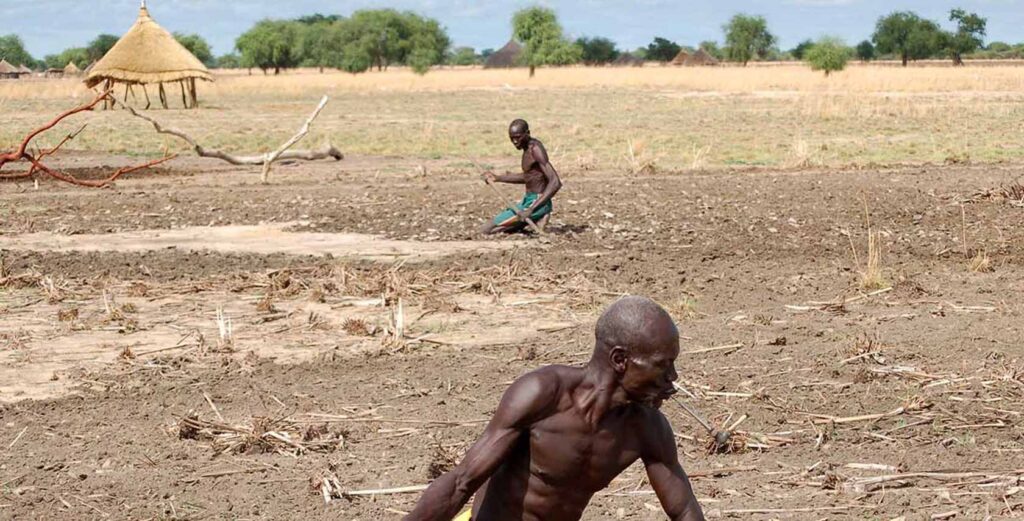
Food crises in Africa are putting tens of millions at risk of starvation as drought ravages nations in the Southern Cone and warfare in Sudan exacerbates famine in the country.
Nations in southern Africa, a region that relies heavily on farming activities, have declared states of emergency after a severe drought decimated crops and ravaged livestock, leaving an estimated 20 million people in a state of acute hunger.
Zimbabwe declared a state of emergency on April 3 after similar steps from Malawi and neighboring Zambia, with the country’s President Emmerson Mnangagwa requesting $2 billion in humanitarian assistance, the Associated Press reported.
The drought has affected more than 6 million people in Zambia and 9 million in Malawi, the majority of them children in both cases, according to the U.N. Children’s Fund.
“This drought has devastating consequences on many sectors such as agriculture, water availability and energy supply, risking our national food security and the livelihoods of millions of our people,” said Zambian President Hakainde Hichilema.
The prolonged dry spell, which the U.N. said is the worst in decades, is the result of El Niño, a weather phenomenon that disrupts weather patterns. During the growing season, the region received less than half of its normal expected rainfall, shriveling crops and killing off livestock.
In the region, February recorded the lowest rainfall in more than a century, according to a report by the Southern African Development Community.
While scientists have said El Niño is the primary cause of the drought, other experts have pointed to the drought as a signal of the long-term effects of climate change. Nii Akuetteh, a political analyst and activist from Ghana, pointed to southern Africa’s devastating cyclones in recent years which have been followed by droughts, such as the one facing the region now.
In northern Botswana and Zimbabwe, average annual temperatures increased by 1.6 to 1.8 degrees Celsius between 1961 and 2010, while the region saw temperatures increase by 1.04 to 1.44 degrees Celsius from 1961 to 2015, according to the Intergovernmental Panel on Climate Change. Regional temperatures are projected to be up to 3.3 degrees Celsius warmer than they were just 20 to 30 years ago. The result is a dryer climate.
“If nothing is done, more people will continue to suffer, more people will continue to die,” he said, noting the urgent need for climate action.
Meanwhile, in northern Africa, nearly five million people are on the brink of famine in Sudan, a man-made crisis that is the result of a year-long war between the country’s army and paramilitary Rapid Support Forces, Reuters reported, primarily in the regions of Khartoum, Darfur and Kordofan.
The war began in April 2023 after RSF members, fighting for civilian rule of the country, were redeployed. Sudan’s army saw the move as a threat, setting off the war and a subsequent hunger crisis.
The World Food Programme estimated that 18 million people, more than a third of the country’s population, are facing acute hunger due to “intensified conflict and growing intercommunal violence, an economic crisis, soaring prices of food, fuel and essential goods, and below-average agricultural production.”
Reuters reported that many are going days without eating and even consuming soil or tree leaves to curb hunger pangs.
In March, the U.N. estimated that more than 220,000 children were projected to die of malnutrition. The ongoing conflict could result in one of three scenarios for the country, per a report by the Netherlands-based think tank Clingendael Institute, with the worst-case scenario being a countrywide famine in which 40% of the country could face catastrophic levels of hunger from May to September.
“Sudan’s war has created the world’s largest hunger crisis,” Anette Hoffmann, a researcher at Clingendael Institute, told Reuters. “We will likely see a famine that we haven’t seen in decades.”



![Banner [Virtual] Art Gallery](https://baystatebanner.com/wp-content/uploads/2024/05/RLJ3-150x150.jpg)


